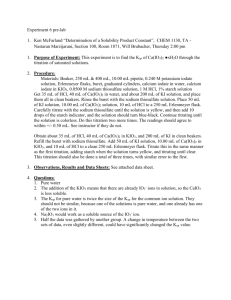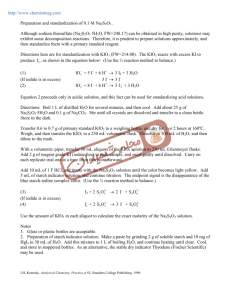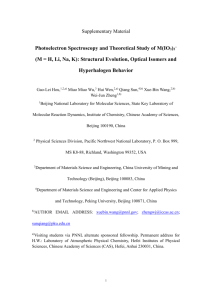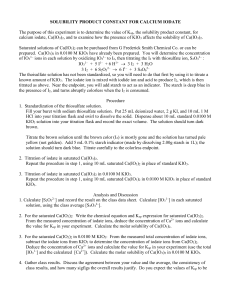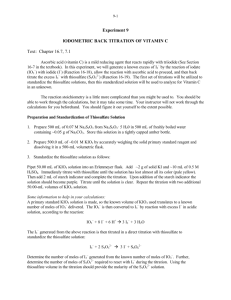experiment 22
advertisement
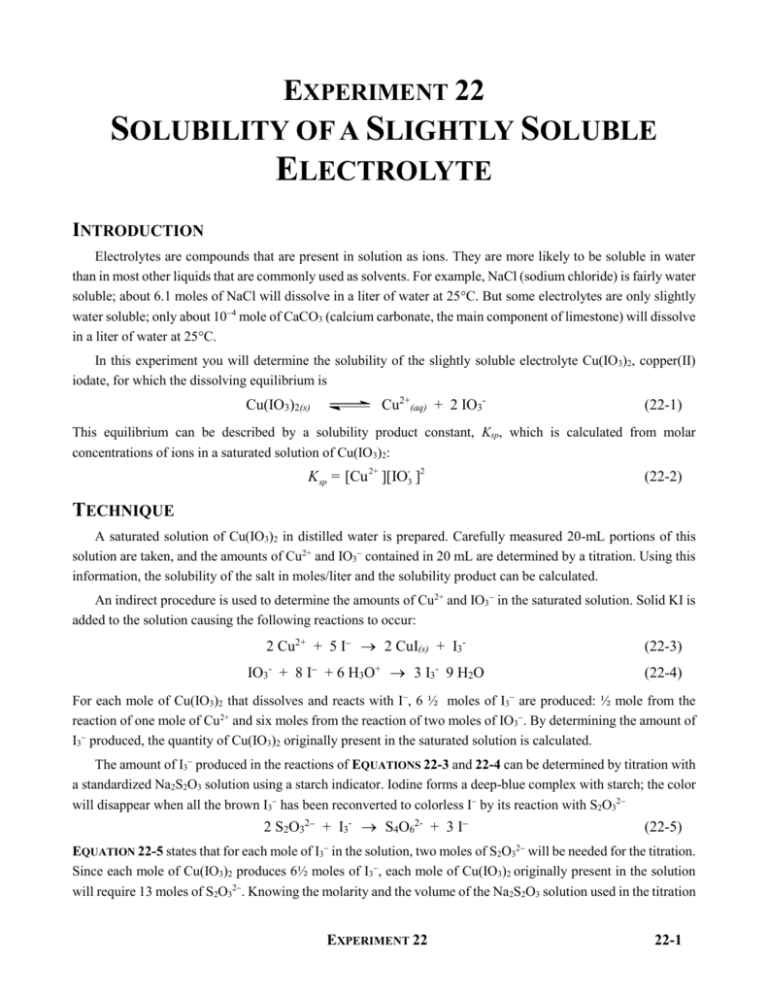
EXPERIMENT 22 SOLUBILITY OF A SLIGHTLY SOLUBLE ELECTROLYTE INTRODUCTION Electrolytes are compounds that are present in solution as ions. They are more likely to be soluble in water than in most other liquids that are commonly used as solvents. For example, NaCl (sodium chloride) is fairly water soluble; about 6.1 moles of NaCl will dissolve in a liter of water at 25C. But some electrolytes are only slightly water soluble; only about 104 mole of CaCO3 (calcium carbonate, the main component of limestone) will dissolve in a liter of water at 25C. In this experiment you will determine the solubility of the slightly soluble electrolyte Cu(IO 3)2, copper(II) iodate, for which the dissolving equilibrium is Cu(IO3)2(s) Cu2+(aq) + 2 IO3- (22-1) This equilibrium can be described by a solubility product constant, Ksp, which is calculated from molar concentrations of ions in a saturated solution of Cu(IO3)2: K sp = [Cu 2+ ][IO-3 ]2 (22-2) TECHNIQUE A saturated solution of Cu(IO3)2 in distilled water is prepared. Carefully measured 20-mL portions of this solution are taken, and the amounts of Cu2+ and IO3 contained in 20 mL are determined by a titration. Using this information, the solubility of the salt in moles/liter and the solubility product can be calculated. An indirect procedure is used to determine the amounts of Cu2+ and IO3 in the saturated solution. Solid KI is added to the solution causing the following reactions to occur: 2 Cu2+ + 5 I 2 CuI(s) + I3- (22-3) IO3- + 8 I + 6 H3O+ 3 I3- 9 H2O (22-4) For each mole of Cu(IO3)2 that dissolves and reacts with I, 6 ½ moles of I3 are produced: ½ mole from the reaction of one mole of Cu2+ and six moles from the reaction of two moles of IO3. By determining the amount of I3 produced, the quantity of Cu(IO3)2 originally present in the saturated solution is calculated. The amount of I3 produced in the reactions of EQUATIONS 22-3 and 22-4 can be determined by titration with a standardized Na2S2O3 solution using a starch indicator. Iodine forms a deep-blue complex with starch; the color will disappear when all the brown I3 has been reconverted to colorless I by its reaction with S2O32 2 S2O32 + I3- S4O62- + 3 I (22-5) EQUATION 22-5 states that for each mole of I3 in the solution, two moles of S2O32 will be needed for the titration. Since each mole of Cu(IO3)2 produces 6½ moles of I3, each mole of Cu(IO3)2 originally present in the solution will require 13 moles of S2O32. Knowing the molarity and the volume of the Na2S2O3 solution used in the titration EXPERIMENT 22 22-1 permits the calculation of the number of moles of S2O32 used and of the number of moles of Cu(IO3)2 originally present in the solution. First you must determine the molarity of the Na2S2O3 solution; this is called standardizing the solution. For a Na2S2O3 solution, this must be done shortly before the solution is used, for S2O32 is not stable in solution for extended periods of time. The solution that will be supplied is ~0.08 M, but its molarity must be determined to a greater number of significant figures. Weighed samples of KIO3 are dissolved in distilled water and then treated with excess I to produce I3 via the reaction of EQUATION 22-4. The I3 is then titrated with Na2S2O3 solution. Since the number of moles of IO3 is known from weighing, the number of moles of S2O32 required for the titration can be calculated from EQUATIONS 22-4 and 22-5. Because this number of moles must be contained in whatever volume of Na2S2O3 solution was used in the titration, the molarity can then be calculated. EQUIPMENT NEEDED balance graduated cylinder beaker buret 10-mL volumetric pipet buret clamp pipet pump or bulb Erlenmeyer flasks funnel CHEMICALS NEEDED Cu(IO3)2; copper(II) iodate (or a saturated solution) HC2H3O2; glacial acetic acid KI; potassium iodide KIO3; potassium iodate 0.08M Na2S2O3; sodium thiosulfate 0.2% starch solution PROCEDURE A. Preparation of Saturated Cu(IO3)2 Solution Omit this part of the experiment if a saturated solution is supplied. B. Standardization of Na2S2O3 Solution Obtain about 150 mL of ~0.08 M Na2S2O3 in a beaker. The beaker must be clean, but it need not be dry; if it is wet, swirl the solution over the entire inside wall to wash all the water into the solution homogeneously. This is all of the Na2S2O3 solution that you will use for the entire experiment and is more than you should need. After the standardization, save the remaining Na2S2O3 solution. Clean a buret and rinse it with three 3- mL portions of the Na2S2O3 solution; then fill the buret with this solution. Place a 125 mL Erlenmeyer flask on an analytical balance and tare the balance. Weigh 0.10–0.11 g of KIO3 into the flask and record the exact mass. Dissolve the KIO3 in 25–30 mL of distilled water. Weigh ~0.8g of KI into a beaker, add it to the KIO3 solution, and swirl the flask until all of it dissolves. Add 2 mL of glacial acetic acid to this mixture and swirl the flask to mix it in homogeneously. The mixture should be brown in color because I3 is formed in the reaction of IO3 and I. EXPERIMENT 22 22-2 CAUTION!: Glacial acetic acid is corrosive. If you get it on your skin, wash it off immediately under lots of cold, running water; if you spill any on the outside of the bottle or on the table top, sponge it off and wash out the sponge. Immediately begin to titrate this mixture with the Na2S2O3 solution. The brown color will gradually become lighter as S2O32 converts I3 to colorless I. When the solution is pale yellow, add 2 mL of starch solution to the mixture. (The cylinder that you used to measure acid does not have to be rinsed out before you measure starch, but it does have to be rinsed out before you measure acid again after measuring starch.) The remaining I3 will form a deep-blue complex with the starch; if the color is brownish instead of blue, you can continue with the titration, but for the next titration you should let the solution become a lighter yellow before you add the starch. Titrate until the blue color just disappears showing that all of the I3 has reacted. Weigh out and titrate two more portions of KIO3. If you have time, calculate the molarity of the Na2S2O3 solution for each trial (see the Calculations and Results section below). If you do not have two consecutive titrations that agree within 1% for the molarity of the Na2S2O3 solution, repeat the titration with new portions of KIO3 until you do have this agreement. Note: you will record your three best trials onto the Chem21 report sheet. To discard a solution after you finish a titration, wash it down the drain with lots of water. C. Determination Of Cu(IO3)2 Solubility Obtain ~40 mL (no more!) of the saturated Cu(IO3)2 solution. If the solution is cloudy, begin by removing any undissolved solid from the solution by filtration. Be sure the funnel and all glassware that you use in this filtration are clean and dry; do not wet the filter paper with water before you begin the filtration. Because you want to know the concentration of the solute in a saturated solution, it is essential that you do not dilute the solution. If the filtrate is cloudy, repeat the filtration. Filter all of the solution before you begin the titrations. Pipet 10.00 mL of the clear filtrate, the saturated Cu(IO3)2 solution, into an Erlenmeyer flask (which must be clean, but not necessarily dry). Add about 10 mL of distilled water, 0.2 g of KI, and 1.0 mL of glacial acetic acid. Immediately titrate this solution with your standardized Na2S2O3 solution following the same procedure you used in the standardization. Repeat the titration with two more 10.00-mL portions of the saturated Cu(IO3)2 solution. If you have time, calculate the molarity of the Cu(IO3)2 solution for each trial (see the Calculations and Results section below). If you do not have two consecutive titrations that agree within 1% for the molarity of the Cu(IO3)2 solution, repeat the titration with new portions of Cu(IO3)2 until you do have this agreement. Note: you will record your three best trials onto the Chem21 report sheet. To discard a solution after you finish a titration, wash it down the drain with lots of water. Any unused Na2S2O3 solution and Cu(IO3)2 solution may also be washed down the drain. EXPERIMENT 22 22-3 CALCULATIONS AND RESULTS B. Standardization of Na2S2O3 Solution Calculate the number of moles of KIO3 in each sample that you weighed. EQUATION 22-5 shows that two moles of S2O32 are required to titrate each mole of I3, and EQUATION 22-4 shows that each mole of IO3 in your sample KIO3 produces three moles of I3. Thus, the number of moles of S2O32 used in a titration is six times the number of moles of KIO3. This is the number of moles of S2O32 contained in the volume of Na2S2O3 solution used in the titration. The molarity of the Na2S2O3 solution can be calculated from the definition M= moles S2O32– 6 (moles KIO3 ) = liters of solution liters of Na 2S2O3 solution (22-6) Average your trials that agree within 1% and use this value as the molarity of the Na 2S2O3 solution in the remaining calculations. C. Determination of Cu(IO3)2 Concentration From the volume of Na2S2O3 solution required to titrate the 10-mL portions of saturated Cu(IO3)2 and from the molarity of the Na2S2O3 solution, calculate the number of moles of S2O32 used: moles S2O32– = M (liters of S2O32– used) (22-7) From the information given in the INTRODUCTION moles Cu(IO3 )2 = moles S2O32– 13 (22-8) This is the number of moles of Cu(IO3)2 contained in 10.00 mL of solution; use this to calculate the number of moles of Cu(IO3)2 in 1.000 L of solution, that is, the molarity of Cu(IO3)2 in a saturated solution. Because the solution is saturated, this concentration represents the molar solubility of Cu(IO3)2. Write the concentration expression for Ksp of Cu(IO3)2, first in terms of molar concentrations of Cu2+ and IO3, and then in terms of molar solubility, s. For each of the titrations you carried out with the saturated Cu(IO3)2 solution, calculate Ksp using the value of s that you determined. For your reported value of Ksp take the average of the values you obtained for your best three trials . EXPERIMENT 22 22-4 EXPERIMENT 22 REPORT SHEET Name: _______________________________________ Date:__________ B. STANDARDIZATION OF Na2S2O3 SOLUTION TRIAL 1 TRIAL 2 TRIAL 3 Mass of KIO3 ___________ ___________ ___________ Moles of KIO3 ___________ ___________ ___________ Moles of S2O32 needed ___________ ___________ ___________ Volume of Na2S2O3 used (mL) ___________ ___________ ___________ Molarity of Na2S2O3 ___________ ___________ ___________ Average molarity _____________________________ For TRIAL 1, show the calculation of the molarity of the Na2S2O3 solution. EXPERIMENT 22 22-5 C. DETERMINATION OF Cu(IO3)2 SOLUBILITY Average molarity of Na2S2O3 _________________ TRIAL 1 TRIAL 2 TRIAL 3 Volume of Na2S2O3 used (mL) ___________ ___________ ___________ Moles of S2O32 used ___________ ___________ ___________ Moles of Cu(IO3)2 present ___________ ___________ ___________ Volume of Cu(IO3)2 (mL) ___________ ___________ ___________ Molarity of Cu(IO3)2 ___________ ___________ ___________ Molar solubility of Cu(IO3)2 ___________ ___________ ___________ Ksp ___________ ___________ ___________ Average Ksp _______________________ For TRIAL 1, show the calculation of moles of Cu(IO3)2 present. For TRIAL 1, show the calculation of molar solubility of Cu(IO3)2. For TRIAL 1, show the calculation of Ksp. EXPERIMENT 22 22-6 Notes Experiment 22 Changes in Procedure: • Omit Part A. The Cu(IO3)2 solution has already been prepared. • Obtain ~40 mL of the Cu(IO3)2 solution—you shouldn’t any more than that, and it’s an expensive material! • You should filter the Cu(IO3)2 solution prior to titration only if it is cloudy. • You will work in pairs on this experiment. Helpful Hints: Use a disposable pipet to deliver the glacial acetic acid to the titration mixture. Bureting tips: - Make sure the buret is clean. Rinse the buret with water and then a small amount of thiosulfate solution before filling the buret. - Remember to open the stopcock so that the buret tip is filled with solution before recording your initial volume reading. Record the initial volume at the bottom of the meniscus to two decimal places. Your initial volume does not have to be 0.00 mL. - Swirl the flask continuously as you titrate. - Rinse out the buret with water before returning! • Titrate carefully! Part of your grade will be determined by how close your calculate Ksp is to the actual value. EXPERIMENT 22 22-7
